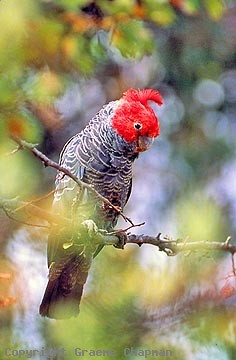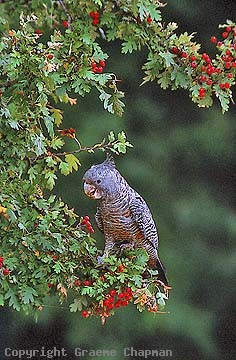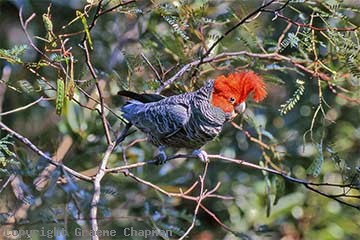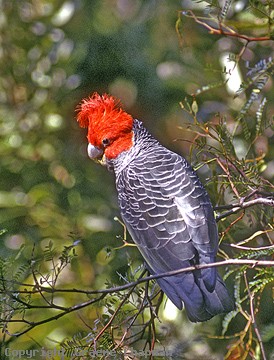Australian BirdsGang-gang Cockatoo
|
Gang Gangs are generally regarded as birds of the cold country - they are certainly abundant in places where there is snow in winter, but there are also smaller breeding populations in lowland and coastal forests. They do move around in search of food but little is known about these movements - they are more likely to be younger birds. There does seem to be altitudinal movement in winter from the high country to the lowlands. Once they are adult, which takes about three years, they would tend to stay in a permanent breeding territory for life, perhaps only moving locally in search of food. Like Galahs, they are very loyal and pair for life. If one of a pair dies, they are very selective about choosing another mate, usually only another one of their own community if one becomes available.
Mainly found in NSW and Victoria, there is the odd record from far SE South Australia, Tasmania, and introduced to Kangaroo Island but extinct on King Island In NSW there are a couple of records of single birds from near Coffs Harbour and I saw a pair in montane forest near Ebor in 1967, but the principal range is from about the Hunter River southwards. They are quite frequently seen around Canberra where they have taken to feeding on the berries of Cotoneaster and Crataegus bushes along the roadsides and visit peoples' backyards and feeders. They even nest on the slopes of Black Mountain quite close to the city centre. Gang Gangs are fairly quiet cockatoos and can easily be overlooked. Their creaky-crackly calls, usually given in flight, do not carry very far. Usually encountered in pairs or family groups when breeding, winter flocks normally number up to 30 or so. The largest flock I ever saw was around the Blue Range Forestry Camp west of Canberra back in 1964 where there were nearly 300 birds. |

268001 ... Gang-gang Cockatoo, adult male. |

268009 ... Female feeding on introduced hawthorn, Canberra, A.C.T. |

268201 ... What a head-dress! This is probably an old male. |

268203 ... Gang Gang Cockatoo, male |
